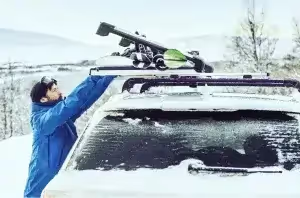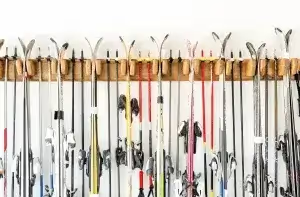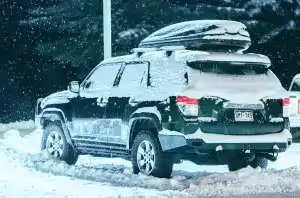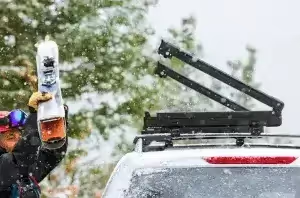How Ski and Snowboard Racks Work? Expert Guide
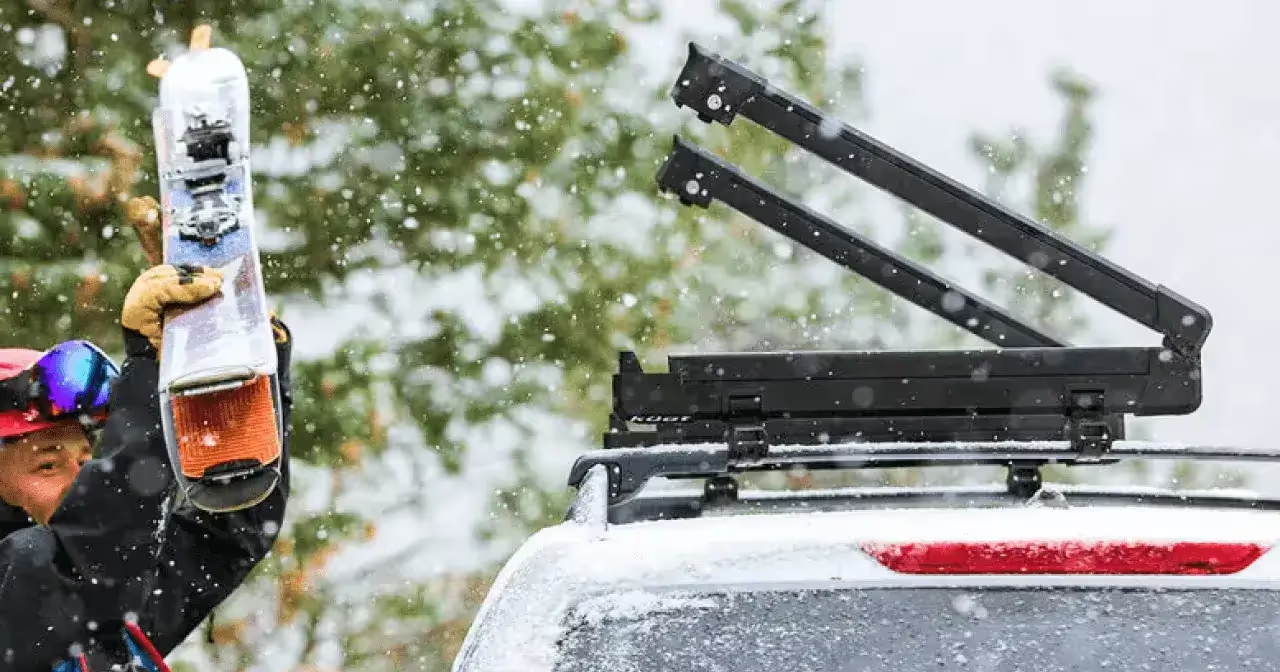
With many years of experience working with major automotive manufacturers I am excited to provide you with valuable insights and tips on how ski racks work and how to transport your skis safely and conveniently.
Whether you're a seasoned skier or new to the sport, ski racks are an essential accessory for any winter adventure. They attach to the crossbars on your vehicle's roof and securely clamp down onto your skis.
But how do ski racks actually work?
If you've never used one before, it's important to understand the ins and outs of this handy device. I'll walk you through the process step by step, making it easy for you to load and unload your skis with confidence.
Additionally, I'll explore alternative options such as rooftop cargo boxes and ski racks attached to your vehicle's hitch, giving you a comprehensive overview of all your choices.
In this guide, I'll also provide you with valuable insights and recommendations to help you make the best decision when it comes to choosing the right ski rack for your vehicle.
How to Install a Ski Rack
Installing a ski rack onto your vehicle’s roof is very easy and takes a few minutes. Before attempting to install a ski rack, you’ll need to have crossbars already mounted on your vehicle.
Steps for Installing a Ski Rack (may vary depending on the model of the ski rack):
- Position the ski rack on the center or side of the crossbars.
- Attach plastic mounting clips.
- Set the rack on top of the mounting clips. Be sure that the mounting clip holes align with the holes on the rack.
- Insert bolts and other necessary hardware included with your ski rack. Check the installation guide provided with your rack.
- Repeat the steps for the second half of the ski rack installation.
Below is a video showing how ski racks work. Although your vehicle and ski rack model may be different, the video is helpful to get a general understanding of the installation process.
How to Load Skis on a Roof Ski Rack
- Open the ski rack from the side of the vehicle (typically the passenger side).
- Pair the skis together bottom-to-bottom and place them in the middle of the roof rack with the tails facing forward.
- Be sure that the binds are between the front and rear roof rack bars.
- If loading more than one set of skis, distribute them evenly across the rack, leaving at least 1 inch between them.
- Close and lock the ski rack bars and ensure the skis are properly affixed.
Which Way Should Skis Face on a Ski Rack?
It is important to position skis properly when loading a ski rack.
The skis should be positioned with the tails facing the front of the car (into the wind).
This prevents wind from catching underneath the tips of the skis, causing stress on the skis and the ski rack. High amounts of stress on these parts can cause damage.
Ensure that skis are positioned and secured properly before driving.
Should Snowboard be up or Down on Ski Rack?
The orientation can depend on the type of rack you have and your personal preference.
Bindings Up: Most people place their snowboard on the rack with the bindings facing up. This way, the flat base of the snowboard is against the rack, which can provide a more stable fit. Having the bindings up can also prevent road grime and salt from getting into the bindings.
Bindings Down: Some people prefer to place the snowboard with the bindings facing down, especially if they have a specific rack designed for snowboards. This can reduce the wind resistance a bit, but it might expose the bindings to more road debris.
Can You Put Ski Poles on a Ski Rack?
If you’re going on a ski trip, you most likely have ski poles that need to be transported along with your skis, but can you put them in the ski rack?
Most rooftop ski racks can also hold ski poles securely, making it easy to transport all your ski gear.
Read the manual included with your ski rack to determine if ski poles can be carried safely. Always check your ski rack before driving to ensure all items are secure.
Can I Put Snowboards on a Ski Rack?
Many ski racks are designed to accommodate both skis and snowboards, and vice versa.
However, it's essential to consider the rack's design and capacity, as a rack might hold fewer snowboards than skis due to their thickness.
Can I Use a Ski Rack Without Crossbars?
While most rooftop ski racks are designed to be attached to crossbars, some models are intended to be used on a bare roof.
The SeaSucker Ski Rack uses 6-inch vacuum mounts to securely attach to the roof of your car, therefore crossbars are not required. It can attach to glass or metal and can be used on a wide variety of vehicle designs.
Alternatively, you can use a hitch ski rack to transport skis. This method requires no crossbars since the skis are mounted on the rear of the vehicle.
Many hitch ski racks, such as the Thule Tram, attach directly to an existing bike rack, making it great for those who have a compatible rack already. Other hitch ski racks are standalone and attach directly to the hitch on your vehicle.
Different Types of Ski Racks
There are 3 main types of ski racks available on the market. It is important to know about each type of ski rack to determine which is best for your needs.
1. Roof Ski Racks
A roof ski rack is the most common type of ski rack. It attaches to your vehicle’s crossbars and clamps down on both ends of the skis.
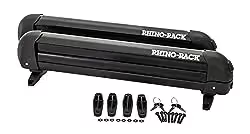
Roof ski racks are the least expensive type of ski rack. You can find one for less than $100, although high-quality models start at the $200 price point.
A roof ski rack is best for the average skier, but it should be avoided if you have expensive skis because they can become damaged.
View roof ski racks on Amazon.
As always, Thule make amazing ski racks that now even include extenders to fit more gear.
The Snowpack model comes in two options that holds either 4 or 6 pairs of skis. The 6 pair extender can also fit 4 skis and 2 snowboards.
Check the price & availability.
2. Ski Cargo Boxes
The second most common type is a rooftop ski cargo box. A cargo box is a large container that attaches to the roof to hold skis and whatever else you can fit.
Cargo boxes can be used for much more than just skis, therefore they can be used for other activities.
The only downside to using a cargo box is the price. Cargo boxes typically cost between $200 and $1,100 depending on the quality, features, and aerodynamics of the box.
A cargo box is best for those who have expensive skis since a cargo box will protect them. It is also great if you need to carry other gear and don’t have space inside your vehicle.
View ski cargo boxes on Amazon.
Also check out: Ski Racks vs. Cargo Boxes
If you have a roof box, you might just need to add a ski holder (often called adopter) to securely clip your skis or snowboard to keep it in place.
The quick video below shows how it works.
3. Hitch Ski Racks
Hitch ski racks attach to the rear of your vehicle by mounting to a hitch.
Many hitch ski racks attach to a hitch-mounted bike rack, rather than being a standalone rack.
If you don’t already have a compatible bike rack, some hitch ski racks are designed as a full system, therefore not requiring a bike rack.
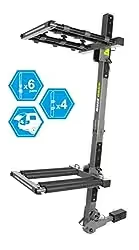
Hitch ski racks are best for those who already own a compatible bike rack and want to easily switch between bicycling and skiing/snowboarding when the seasons change. They are also great if you are unable to use a roof ski rack since you can purchase a complete hitch ski rack system.
View hitch ski racks on Amazon.
Can You Go Through a Car Wash with a Ski Rack?
Car washes are a great way to clean your car quickly when traveling, but you should stop before driving into one with a ski rack attached.
Automatic car wash brushes can tangle in the ski rack and cause damage, therefore you should not take your car through a car wash with a ski rack attached.
This applies to all types of ski racks, including hitch-mounted racks. Automatic car wash brushes can easily wrap around the parts of the rack and rip them apart. This can result in bent metal and snapped plastic.
Bottom Line for Choosing the Right Ski and Snowboard Rack
Ski racks are an essential accessory for safely transporting your skis on the roof of your vehicle.
First and foremost, ski racks attach to the crossbars on your vehicle's roof and securely clamp down onto your skis. This ensures that your skis are held in place and protected during transportation.
Skis can also be carried in a rooftop cargo box or on a ski rack attached to your vehicle's hitch, providing alternative options for ski storage.
For those who haven't used a ski rack before, it's important to familiarize yourself with the installation process to avoid any potential damage to your vehicle or skis.
Additionally, consider investing in a lock for your ski rack to prevent theft and provide added security.
When choosing a ski rack, consider factors such as the size and weight capacity of your skis, as well as the compatibility with your vehicle's roof system. It's also worth noting that some ski racks offer additional features, such as adjustable clamps or padding, to accommodate different ski sizes and protect your equipment from scratches.
From my work experience, I highly recommend investing in a high-quality ski rack. Look for reputable brands and read customer reviews to ensure you're making a wise investment. Your skis are valuable equipment, and proper transportation is essential to maintain their performance and longevity.
So, whether you're planning a day trip or a week long winter vacation, make sure to equip your vehicle with a reliable ski and snowboard rack.
*proof-read by @Mike Rollins



